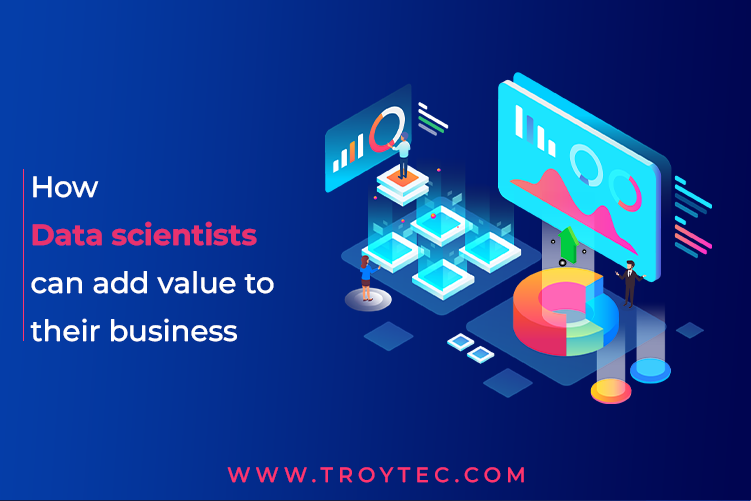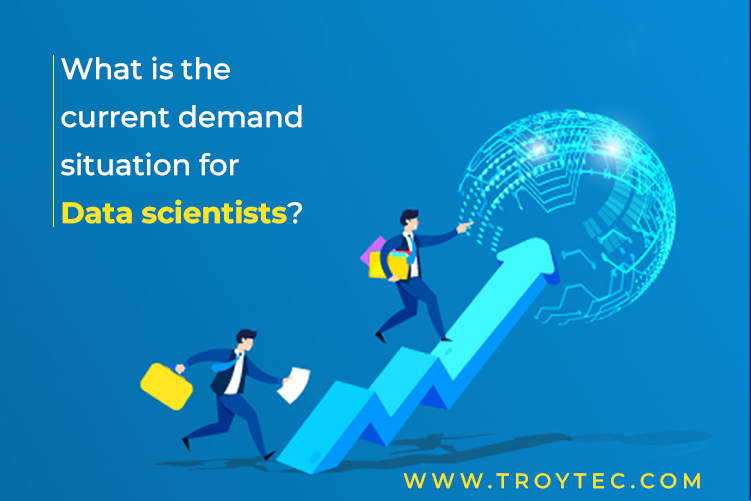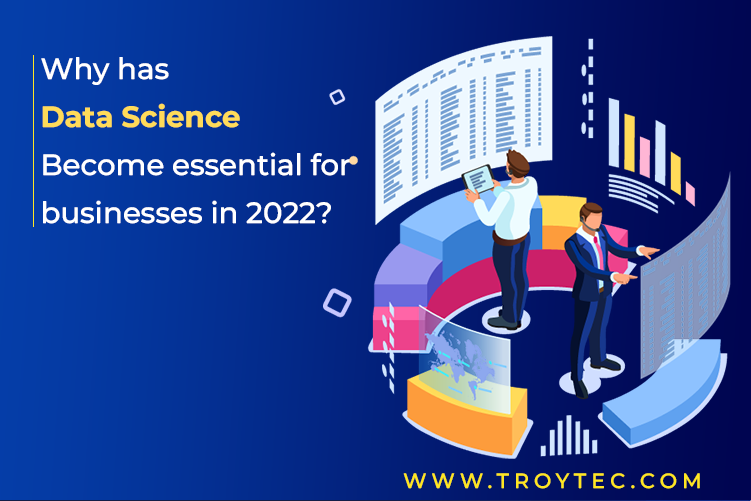Who is Data Scientists? Why has Data Science Become Essential for Businesses in 2022?
Data science facilitates ideas that put together insights and related strategies. It uses science and technology, processes, algorithms, and frameworks to derive information and experience from noisy, unorganized, unstructured data and information from data across a wide range of uses. And an interdisciplinary field that applies substantial knowledge.
Data science is associated with information mining, AI, and big data. Data scientists specify which questions must be addressed and where to track related information. Data scientists can mine, clean up, and present information and the agility and scientific capacity of the business. Organizations use information technology to procure, justify, and analyze a large amount of unstructured information, thereby harnessing the potential of data science in their business activities.
What do data scientists do?
Most data scientists in the industry are highly trained in statistics, mathematics, and computer science. Their experience extends to the vast horizon of data visualization, data mining, and information management. They also have expertise in cloud computing, infrastructure design, and relatively standard data warehousing.
Big data is nothing without expert expertise to turn cutting-edge technology into actionable insights. Today, more and more organizations are opening the door to big data, unleashing its power, and boosting the value of data scientists who understand how to derive actionable insights from gigabytes of data.
It is becoming clear that data processing and analysis are of tremendous value. Data scientists are in the limelight there. Executives have heard how data science is a hot industry, and data scientists are like everyday superheroes. However, most people are still unaware of data scientists’ value in their organizations. Hmm. Let’s take a look at the advantage of data science.
Reduce risk and fraud: Data scientists are trained to identify prominent data somehow. They create predictive fraud trend model statistics, network, path, and extensive data methodologies and use them with alerts to help ensure a timely response when anomalous data is recognized.
Delivery of related products: One of the benefits of data science is that organizations can determine when and where their products sell best. It helps companies deliver the right products at the right time and develop new products that meet their customers’ needs.
Personalized customer experience: One of the most talked-about benefits of data science is that your sales and marketing teams can understand your audience well. With this knowledge, organizations can create the best possible customer experience.
What skills are required to become a Data Scientist?

Arithmetic
Data scientists must be familiar with the concept of mathematics. You can start by working towards a basic understanding of linear algebra, calculus, statistics, and probabilities.
Programming
You need to convert your math skills into a program. The most popular languages in data science are Python and R.
Machine learning
Data scientists make extensive use of machine learning models. Beginners need to know how to use techniques such as logistic regression, decision trees, and support vector machines.
Data storytelling
Data scientists need to know the best visualization type (graphs, charts, etc.) for different data types. Data storytelling also requires presentation skills. It can improve presentation skills by practicing public speaking skills and giving regular presentations.
How data scientists can add value to their business

1. Enable management and executives to make better decisions
Experienced data scientists have the potential to become trusted advisors and strategic partners for senior management in an organization by enabling staff to take full advantage of their analytical capabilities. Data scientists convey and demonstrate the value of institutional data to help improve the decision-making process across the organization by measuring, tracking, and recording performance metrics and other information.
2. Direct actions based on trends-this help define goals
After investigating and investigating your organization’s data, data scientists recommend and prescribe specific actions that help improve your organization’s performance, strengthen customer relationships, and ultimately increase profitability.
3. Adopt best practices and challenge staff to focus on critical issues
One of the tasks of a data scientist is to ensure that staff is familiar with and familiar with the organization’s analytical products. They prepare staff to succeed in demonstrating the effective use of the system to extract insights and facilitate behavior. Once the team understands the product’s capabilities, they can shift their focus to addressing critical business challenges.
4. Identifying opportunities
Data scientists question existing processes and assumptions to develop additional methods and analysis algorithms while interacting with the organization’s current analysis system. The value gained from organizational data needs to be continually and continuously improved in their work.
5. Quantifiable data-driven evidence-driven decision making
With the advent of data scientists, collecting and analyzing data from various channels eliminates the need to take high risks. Data scientists build models using existing data that simulate different potential actions. This way, the organization can know which path will yield the best business outcomes.
6. Test these decisions
Half of the battle involves making specific decisions and implementing those changes. How about the other half? It is essential to know how these decisions have affected your organization. That is where data scientists come in. It is beneficial to have someone measure critical indicators related to significant changes and quantify their success.
7. Identify and improve your target audience
From Google Analytics to customer surveys, most organizations have at least one source of customer data collected. However, the data will not be helpful if it is not used correctly, such as to identify demographics. The importance of data science lies in the ability to capture existing data that is not indeed useful on its own and combine it with other data points to generate insights that organizations can use to learn more about their customers and audiences.
Data scientists can help identify critical groups accurately by thoroughly analyzing different data sources. This in-depth knowledge permits organizations to tailor assistance and products to their customer parties and boost profit margins.
8. Recruiting the right people for your organization
Reading resumes is a daily chore in recruiters’ lives, but it is changing because of big data. Data scientists have access to a large amount of information about their talent through social media, corporate databases, and job search websites, so you can explore all these data points to find the best candidate for your organization’s needs. Data science enables recruiting teams to make faster and more accurate choices by mining the vast amounts of available data, in-house processing of resumes and applications, and advanced data-driven aptitude tests and games.
What is the data science process?
The data is everywhere. Next, let’s look at how data is transformed into information to guide business decisions.
Problem framing
Every data science project begins with assembling the problem at hand. Before undertaking a project, you need to contextualize the problem within the goals of a larger organization. It is also essential to precisely assemble the problem. What business are you trying to achieve? What are its goals, and what challenges do they face? Answering these questions will help you set the correct tone for your project.
Data collection
Then collect data to help you solve the problem. You can use either company-internal data or publicly available data. Be aware of the types of resources available for your particular project. To get the data you need, you must determine what money and time you need to invest.
Data cleaning
It was not yet suitable for analysis when you first retrieved the data. Using heuristic methods, you need to clean up your data to eliminate redundancy, remove corrupted entries, and enter missing values .
High-level analysis
Once your data is ready, you can gather some insights through a high level of exploratory analysis. This reveals some of the more apparent patterns that exist in the dataset. Not only does this help you quickly gather some valuable insights, but it can also direct you go through the rest of the process in terms of the trends you are looking for and the characteristics you are looking for.
Detailed data analysis
This is where all the robust data analysis is done. You need to choose the right tools for your data analysis carefully. There are many different artificial intelligence techniques and analytical tools that you can use to extract insights from your data. However, you need to justify each algorithm’s use based on how it matches the problem you are trying to solve.
For example, imagine you are trying to forecast the success of a new product. In that case, you need to build a predictive model and select the appropriate feature vectors and algorithms. It is easy to get distracted by all the tools you have at your disposal, so focus on the problem.
Communication of results
In the final stages of the data science process, share your findings with other stakeholders. This is an underrated soft skill in the industry that facilitates the overall work. The goal is to condense the job done into the most critical points. Visualizations can convey trends in a way that non-technical staff can understand. These skills are known as data storytelling.
What is the current demand situation for data scientists?

There is a gap between the supply and demand of data scientists due to the need for highly specialized knowledge and skills. Anyone involved in data science is aware of this. For example, we currently need more than 150,000 data scientists looking at the United States. There is also a global shortage of data science skills in Europe and Asia.
If you are a company that needs an expert in this area, it can be challenging due to the complexity of the data and each of the company’s unique data practices. Therefore, if you are a data scientist, you need to be good at processing technology and communicating. In addition, the role has a business side, and this is just the beginning. It is also intriguing that a study reveals that 94% of data scientists and graduates have been employed since 2011.
It is 94%, so you will feel very comfortable if you are heading in this direction or are already a data scientist. You have excellent job potential, and this shows how reliable data science career options are today, but they are moving forward in the future. This career path runs parallel with all the digital turmoil on the horizon.
You can see how this can evolve rapidly and grow with the changing landscape of technological progress. Are you Looking at the growth of this data science now? It is also related to other vital factors. You can think of data growth from IoT or Edge social data. Looking a little further, the US Bureau of Labor Statistics predicts that by 2026, there will be 11.5 million jobs in data science and analytics.

